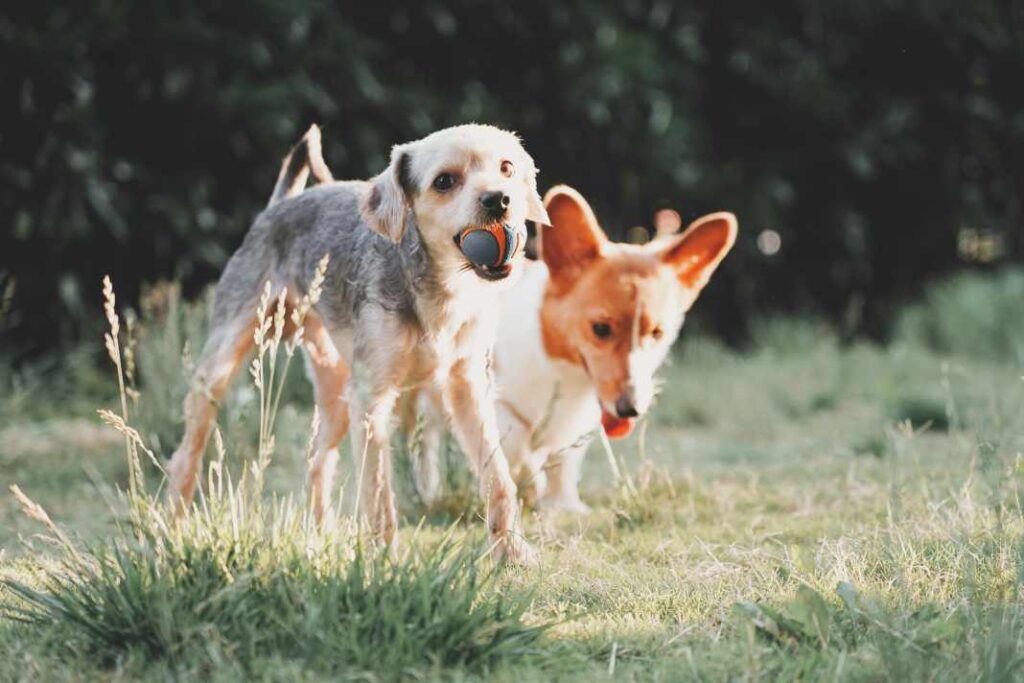Genetic Influences on Canine Aggression: Understanding the role of genetics and the environment in canine aggression and how it can be managed and modified through genetic awareness and environmental management.
Click here for Expert Videos to Stop Dog Behavioral Problems!
Overview of Genetic Influences on Canine Aggression
Canine aggression, a complex behavioral trait, is influenced by a delicate interplay of genetic and environmental factors. Genetic predispositions can significantly impact a dog’s aggressive tendencies, with specific loci such as GNAT3-CD36 and IGSF1 playing a crucial role in fear and aggression towards unfamiliar dogs and humans.
For instance, studies have shown that reduced-fear variants at these genetic loci may have played a vital role in the domestication of dogs, underscoring the evolutionary significance of genetic influences on canine behavior.
Canine aggression is influenced by genetics and environment, necessitating holistic behavior management approaches.
Understanding the genetic underpinnings of aggression in dogs is paramount for effective behavior management and training interventions. Research has highlighted that while genetics lay the foundation for aggressive behavior, environmental factors like socialization, training, and past experiences also play a pivotal role in shaping a dog’s demeanor.
For example, a dog with a genetic predisposition to aggression may exhibit varying levels of aggressive behavior based on its environmental interactions and upbringing, further emphasizing the intricate relationship between genes and the environment in canine aggression.
This complicated balance between genetic predispositions and environmental influences underscores the complexity of canine behavior and the importance of a holistic approach in addressing dog aggression.
Genetic Loci Associated with Canine Aggression
Studies have shown that genes like IGF1 and HMGA2 are associated with specific behaviors in dogs, including separation anxiety, touch sensitivity, and aggression. For instance, the HMGA2 gene has been linked to touch sensitivity, where specific genetic variants may make dogs more reactive to physical stimuli, potentially leading to aggressive responses in specific situations.
Similarly, the IGF1 locus has been associated with separation anxiety. This trait can manifest as aggressive behavior when a dog feels distressed from being separated from its owner or familiar environment.
Research shows genes like IGF1 and HMGA2 influence dog behaviors such as separation anxiety and touch sensitivity, impacting aggression.
Moreover, the CD36 gene, found within the GNAT3-CD36 locus, is of particular interest in understanding canine aggression. This gene is located in brain regions related to fear and aggression, and studies have shown that when the CD36 gene is knocked out in mice, it can lead to increased anxiety and aggression levels.
This highlights the intricate relationship between genetic factors and aggressive behavior in animals. By investigating these specific genetic loci, researchers aim to unravel the complex genetic underpinnings of canine aggression, paving the way for more targeted interventions and management strategies.

Environmental Factors and Canine Aggression
In addition to genetic influences, environmental factors play a crucial role in shaping canine aggression. For example, a lack of proper socialization during a dog’s critical developmental period can lead to fearfulness and aggression towards unfamiliar dogs or humans. This highlights the significance of early socialization practices in preventing aggressive behaviors in dogs.
Moreover, the quality of training a dog receives and its past experiences also play a key role in determining its behavior toward various stimuli. For instance, a dog that has been exposed to positive training methods and diverse environments is more likely to exhibit well-adjusted behavior and reduced aggression.
Environmental factors like socialization, training quality, and past experiences significantly impact canine aggression, alongside genetic influences.
Furthermore, environmental factors can either exacerbate or mitigate genetic predispositions towards aggression in dogs. For instance, a genetically predisposed dog to aggression may display less aggressive behavior if consistently exposed to positive and controlled environments.
Conversely, a dog with a low genetic propensity for aggression may exhibit heightened aggression if subjected to traumatic experiences or neglect. Therefore, understanding the environmental triggers that can influence a dog’s behavior is paramount in managing and curbing aggression effectively.
By providing a nurturing and structured environment alongside appropriate training, pet owners can positively impact their dog’s behavior and reduce the likelihood of aggressive tendencies, showcasing the intricate balance between genetic predispositions and external influences in shaping canine aggression.
Breed-Specific Genetic Influences on Aggression
Research into the genetic influences on canine aggression has shed light on how different dog breeds exhibit varying levels of genetic predisposition to aggressive behavior. For instance, a study led by geneticist Noah Snyder-Mackler at the University of Washington analyzed behaviors across 101 dog breeds using data from the C-BARQ survey and dog genotype databases.
The findings revealed that genes contribute significantly, around 60 to 70 percent, to traits related to aggression and trainability among different breeds. This indicates that genetic factors play a crucial role in shaping behavioral tendencies in dogs, including their inclination towards aggressive behavior.
Research highlights significant genetic contributions to canine aggression, with breed-specific genes affecting behavior and trainability.
Furthermore, specific genetic variants associated with different dog breeds have been identified, underscoring the complexity of behavioral diversity within the canine population. For example, the IGF1 and HMGA2 loci have been linked to separation anxiety, touch sensitivity, and aggression in dogs. In contrast, GNAT3-CD36 and IGSF1 loci play a role in fear and aggression towards unfamiliar dogs and humans.
Understanding these breed-specific genetic influences is essential for both breeders and dog owners to recognize and address potential behavioral issues in specific breeds. By acknowledging the genetic predispositions of different breeds, appropriate training and management strategies can be implemented to mitigate aggressive tendencies and promote overall well-being in dogs.
Management Strategies for Canine Aggression
When considering the management of canine aggression, it is essential to acknowledge the impact of genetic predispositions on behavior. Research has shown that specific genes play a crucial role in influencing aggressive tendencies in dogs.
For example, the IGF1 and HMGA2 loci have been associated with separation anxiety, touch sensitivity, and aggression. By understanding these genetic influences, breeders and owners can make informed decisions to minimize the risk of aggressive behavior in dogs through selective breeding practices and responsible pet ownership.
In addition to genetic factors, environmental interventions are key in managing canine aggression. Socialization, training, and past experiences all contribute to a dog’s behavioral development and aggression levels.
Understanding genetic predispositions and combining them with environmental strategies like socialization can effectively manage canine aggression.
For instance, early socialization can help puppies adapt to different stimuli and environments, reducing the likelihood of fear-based aggression in adulthood.
Professional guidance from animal behaviorists or trainers can also provide valuable insights into modifying aggressive behaviors through positive reinforcement techniques tailored to individual dogs.
By combining genetic awareness with environmental management strategies, owners can take proactive steps to address and mitigate aggression in their canine companions, promoting harmonious relationships and overall well-being for dogs and their caregivers.
Conclusion and Future Research Directions
Genetic influences are a crucial aspect in deciphering the complexities of canine aggression. Studies have shown that genes like IGF1, HMGA2, GNAT3-CD36, and IGSF1 are associated with various aggressive behaviors in dogs. For instance, the CD36 gene, found in brain regions linked to fear and aggression, has been associated with increased anxiety and aggression in animal studies.
Understanding these genetic loci and their implications on behavior can pave the way for more targeted interventions and management strategies tailored to the individual needs of aggressive dogs.
Genetic factors like IGF1 and CD36 influence canine aggression, interacting with environmental factors to shape behavior.
Furthermore, the interplay between genetics and environmental factors in shaping canine aggression opens up avenues for future research. While genes provide a foundation for behavior, environmental influences such as socialization, training, and past experiences also significantly impact a dog’s propensity for aggression.
Research focusing on how these two aspects interact and influence aggressive behaviors can lead to a more comprehensive understanding of aggression in dogs. Moreover, investigating the epigenetic mechanisms that modulate gene expression in response to environmental stimuli can provide valuable insights into the plasticity of aggressive behaviors and potential avenues for intervention.
By delving deeper into the genetic and environmental determinants of canine aggression, researchers can develop more holistic approaches to managing and curbing aggression in dogs, ultimately enhancing the well-being of both dogs and their owners.

Building a Confident Companion: Socialization Tips for Your Growing Puppy

Early socialization is fundamental to developing a well-behaved, confident, and happy dog. By implementing positive reinforcement techniques, maintaining consistent training practices, and seeking professional guidance when needed, pet owners can effectively prevent and address aggression in puppies.
A well-socialized puppy not only displays good manners and behavior but also fosters a strong bond with their human family, significantly enhancing the quality of life for both the dog and their owners.
Continue reading: Socialization Tips for Your Growing Puppy




